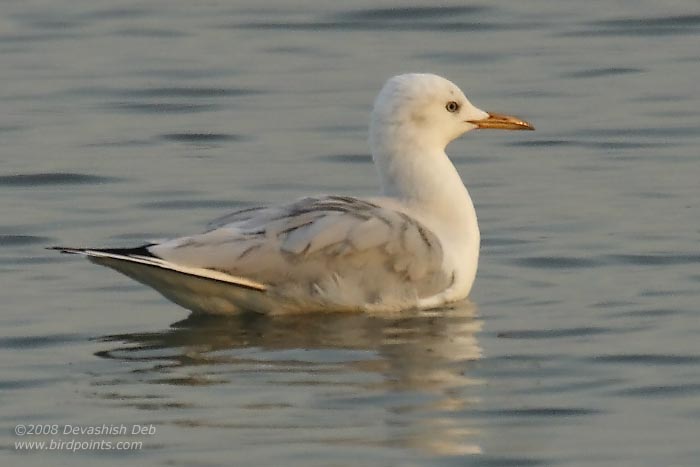|
|
|
Slender-billed Gull
|
Larus
genei
|
|
24 September
2008
|
|
Full
Species (monotypic); i.e. no subspecies/races
Larus genei; Breme, 1839 |
Pls use the mousewheel
to zoom in/out (Max 2X) |

|
|
Jakhau Coast, Near
Naliya, Kutch, Gujarat, India, 19 January 2007
|
Historical
1493. Larus gelastes. The Slender-billed Gull. Larus gelastes, Licht., Thienem. Fortpflanz. Vog. Eur. pt. v, p. 22 (1838); Blanf. Eastern Persia, ii, p. 291; Hume, Cat. no. 981 quat.; Barnes, Birds Bom. p. 426; Oates in Hume's N.&E. 2nd ed. iii, p. 294; Saunders, Cat. B. M. xxv, p. 230. Xema lambruschini, Bonap. Icon. Faun. Ital., Ucc. pp. 135, 136*, pl. 45 (1840). Larus lambruschini, Hume, S.F. i, p. 274; Butler, S. F. v, p. 286. Coloration. Head, neck, under surface, upper tail-coverts, and tail white; all, except the head, suffused with a roseate tinge that disappears generally in dried skins; mantle pearl-grey, coverts and quills a little darker; outer primary-coverts and greater part of first four primaries white; on 1st primary the outer web, tip and edge of inner web, on the 2nd, 3rd, and 4th the tip, a broad inner border and a small portion, varying in amount, of the outer border are black; the 4th is grey on the inner web near the shaft, the 5th and 6th on both webs, they also having black ends; 7th and later primaries grey like secondaries. There is apparently no change in winter. Young birds have some brown on the mantle, retained longest on the wing-coverts and tertiaries; the black portions of the primaries occupy more of the feathers than in adults, and there is a dark brown terminal band to the tail. Bill deep red; eyelids bright red, irides pale yellow; legs and feet deep red (Hume). Immature birds have bill, legs, and feet pale orange. Length of males 18; tail 4.6; wing 12; tarsus 2; bill from gape 2.5. Females are rather smaller, wing 11. Blanford,
W.T. 1895-98. The Fauna of British India, Including Ceylon and Burma. Birds.-
Vol. III-IV.
To a casual observer these birds closely approximate to L. ridibundus in winter plumage; but they may be very readily distinguished from these; they never get the dark hood that ridibundus does, and they never have the dark spot in front of the eye and behind the ear coverts that ridibundus always exhibits in the cold weather; the bills also are considerably longer, and in proportion to their length slenderer than those of ridibundus; the gonys especially is conspicuously longer, measuring from the angle to the tip in this species in males from 0.57 to 0.65; while in the same sex in ridibundus, it measures from 0.45 to 5; lastly, the perfect adults in this species want entirely the black margin on the inner web of the first primary, while this is as far as my experience goes invariably present ever in the fullest breeding plumage of ridibundus. I may add that I never saw this bird except along the sea coast. |
About/Terms of use etc. at the home page
Copyright © 2006-2008 birdpoints. All rights reserved.